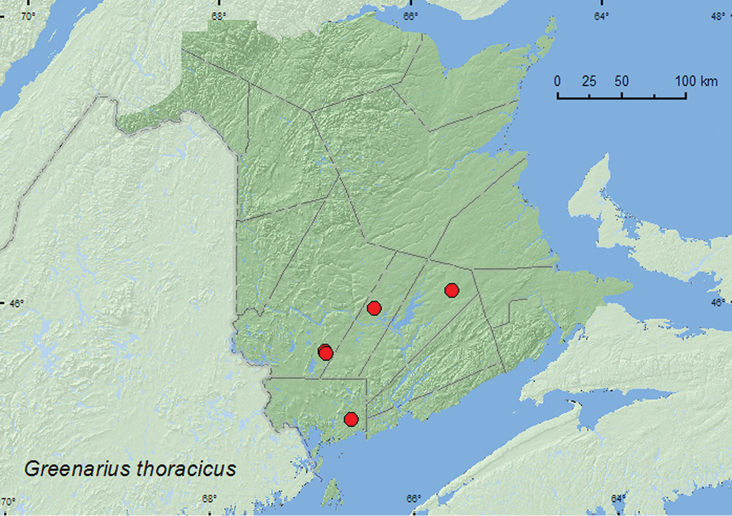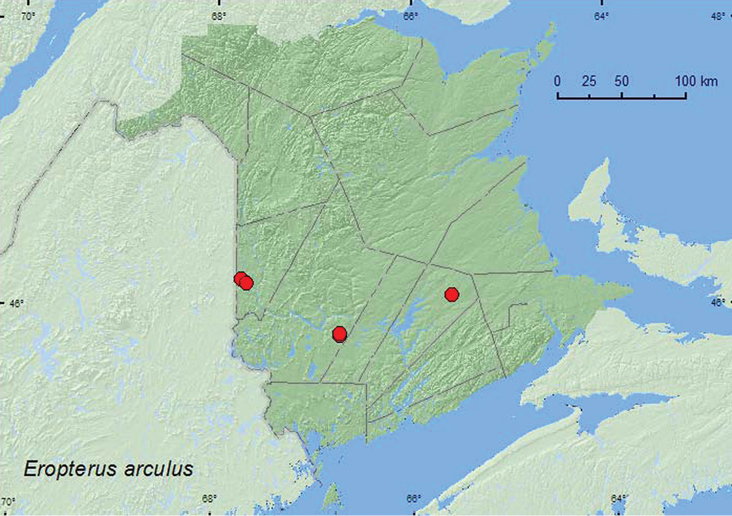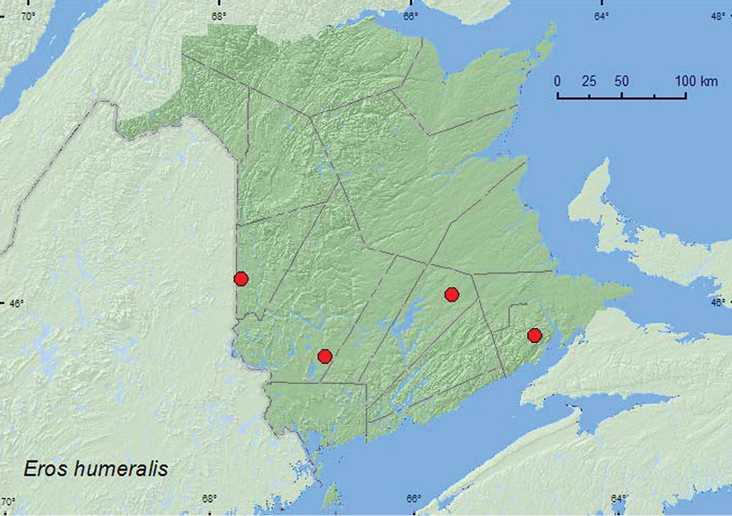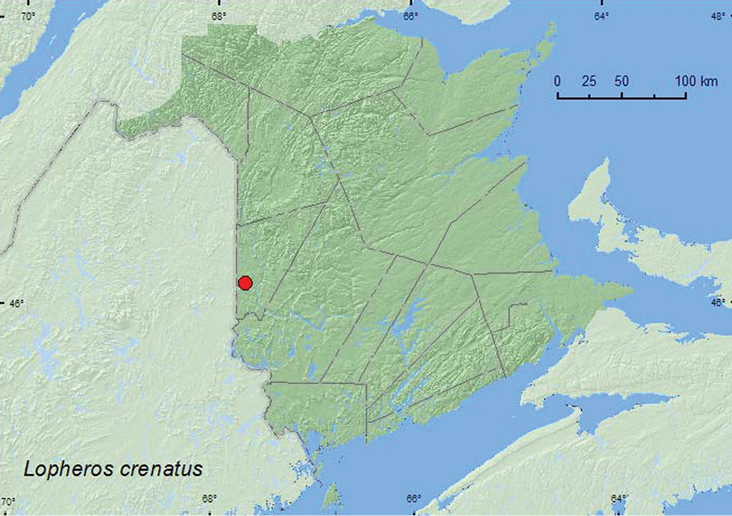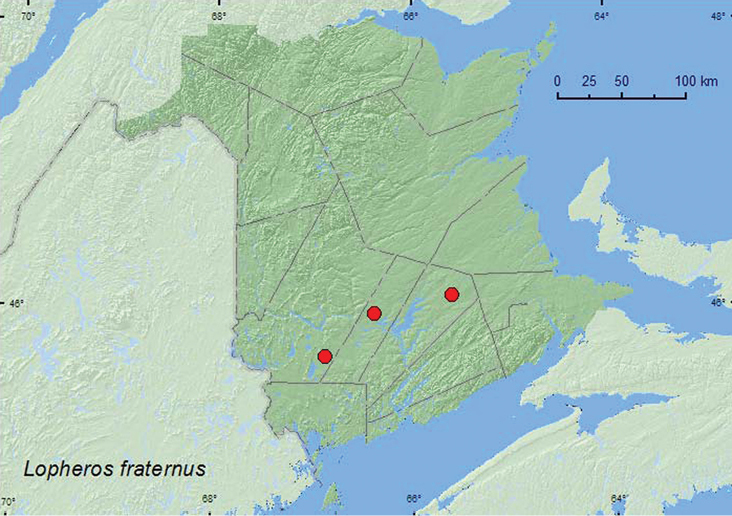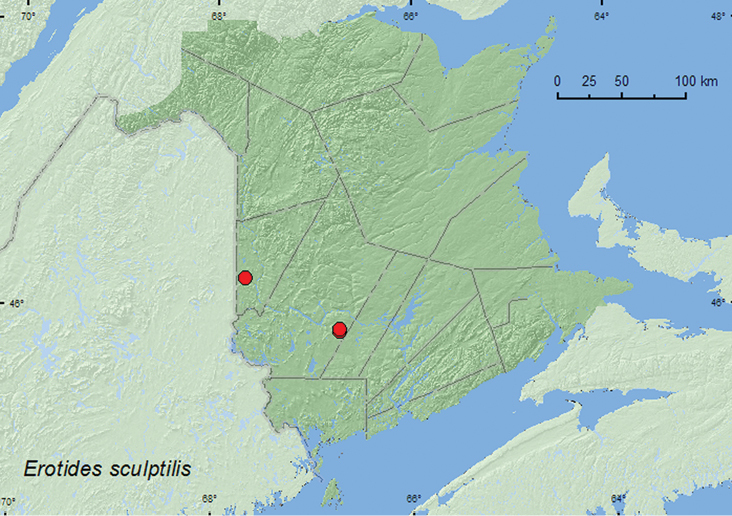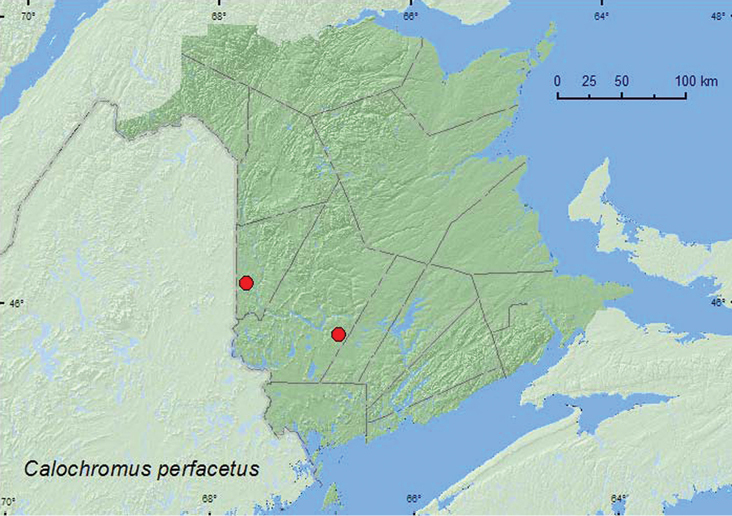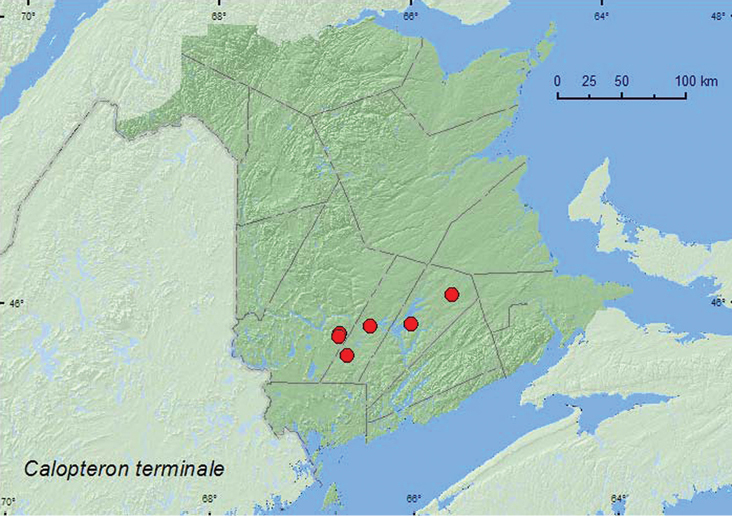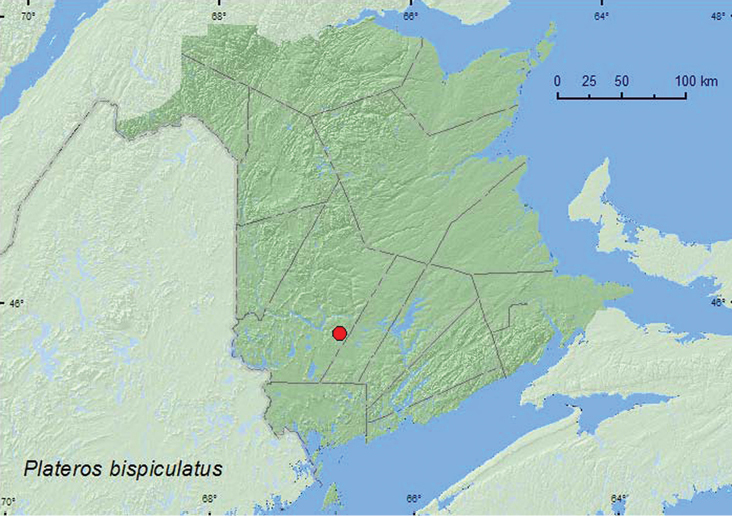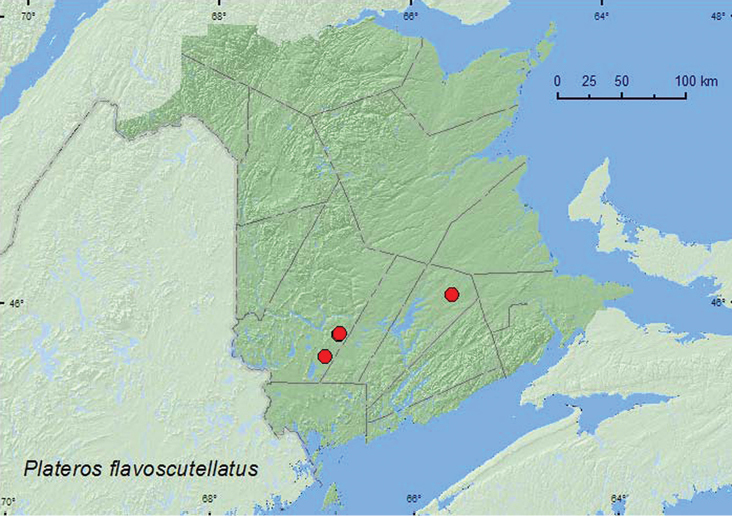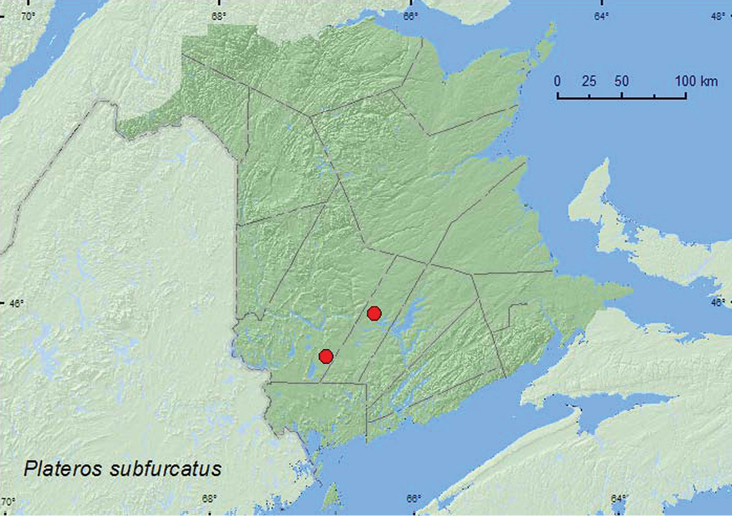






(C) 2012 Reginald P. Webster. This is an open access article distributed under the terms of the Creative Commons Attribution License 3.0 (CC-BY), which permits unrestricted use, distribution, and reproduction in any medium, provided the original author and source are credited.
For reference, use of the paginated PDF or printed version of this article is recommended.
Eight species of Lycidae are newly recorded from New Brunswick, Canada, bringing the total number of species known from the province to 16. The first documented records from New Brunswick are provided for Greenarius thoracicus (Randall) Erotides scuptilis (Say), and Calopteron terminale (Say) reported by
Lycidae, new records, Canada, New Brunswick
The Lycidae of North America was reviewed by
Twenty-nine species are known from Canada and five were reported from New Brunswick by
The following records are based in part on specimens collected as part of a general survey by the first author to document the Coleoptera fauna of New Brunswick.
Collection methodsVarious collection methods were employed to collect the Lycidae reported in this study. Details are outlined
Males of some species of Lycidae (all Plateros sp.) were dissected to confirm their identity. The genital structures were dehydrated in absolute alcohol and mounted on points and then pinned with the specimens from which they originated.
DistributionDistribution maps, created using ArcMap and ArcGIS, are presented for each species in New Brunswick. Every species is cited with current distribution in Canada and Alaska, using abbreviations for the state, provinces, and territories. New records for New Brunswick are indicated in bold under Distribution in Canada and Alaska. The following abbreviations are used in the text:
Acronyms of collections examined or where specimens reside referred to in this study are as follows:
AFC Atlantic Forestry Centre, Natural Resources Canada, Canadian Forest Service, Fredericton, New Brunswick, Canada
CNC Canadian National Collection of Insects, Arachnids and Nematodes, Agriculture and Agri-Food Canada, Ottawa, Ontario, Canada
NBM New Brunswick Museum, Saint John, New Brunswick, Canada
RWC Reginald P. Webster Collection, Charters Settlement, New Brunswick, Canada
| AK | Alaska | MB | Manitoba |
| YT | Yukon Territory | ON | Ontario |
| NT | Northwest Territories | QC | Quebec |
| NU | Nunavut | NB | New Brunswick |
| BC | British Columbia | PE | Prince Edward Island |
| AB | Alberta | NS | Nova Scotia |
| SK | Saskatchewan | NF & LB | Newfoundland and Labrador* |
Eight species of Lycidae are newly recorded from New Brunswick, Canada, bringing the total number of species known from the province to 16 (Table 1). The first documented records from New Brunswick are provided for Greenarius thoracicus (Randall) Erotides scuptilis (Say), and Calopteron terminale (Say) reported by
Species of Lycidae recorded from New Brunswick.
| Family Lycidae Laporte |
| Subfamily Dictyopterinae Houlbert |
| Tribe Dictyopterini Houlbert |
| Greenarius thoracicus (Randall) |
| Dictyopterus aurora (Herbst) |
| Subfamily Lycinae Laporte |
| Tribe Erotini LeConte |
| Eropterus arculus Green** |
| Eros humeralis (Fabricius)* |
| Lopheros crenatus (Germar)** |
| Lopheros fraternus (Randall)* |
| Erotides sculptilis (Say) |
| Tribe Calochromini Lacordaire |
| Calochromus perfacetus (Say)** |
| Tribe Calopterini Green |
| Caenia dimidiata (Fabricius) |
| Calopteron terminale (Say) |
| Leptoceletes basalis LeConte |
| Tribe Platerodini Kleine |
| Plateros bispiculatus Green* |
| Plateros flavoscutellatus Blatchley* |
| Plateros lictor (Newman) |
| Plateros subfurcatus Green* |
| Plateros volatus Green |
All records below are species newly recorded from New Brunswick, Canada unless noted otherwise (additional records). Species followed by ** are newly recorded from the Maritime provinces.
The classification of the Lycidae follows
Additional New Brunswick records. Charlotte Co., 10 km NW of New River Beach, 45.2110°N, 66.6170°W, 29.VI–16.VII.2010, R. Webster & C. MacKay, old growth eastern white cedar forest, Lindgren funnel traps (2, RWC). Queens Co., Cranberry Lake P.N.A. (Protected Natural Area), 46.1125°N, 65.6075°W, 10–15.VII.2009, R. Webster & M.-A. Giguère, old red oak forest, Lindgren funnel trap (1, AFC); same locality data and forest type, 7–13.VII.2011, M. Roy & V. Webster, Lindgren funnel trap (1, RWC). Sunbury Co., Acadia Research Forest, 45.9866°N, 66.3841°W, 24–30.VI.2009, R. Webster & M.-A. Giguère, red spruce forest with red maple and balsam fir, Lindgren funnel trap (1, RWC). York Co., 15 km W of Tracy off Rt. 645, 45.6848°N, 66.8821°W, 29.VII-4.VIII.2009, R. Webster & M.-A. Giguère, old red pine forest, Lindgren funnel trap (1, RWC); 14 km WSW of Tracy, S of Rt. 645, 45.6741°N, 66.8661°W, 16–30.VI.2010, R. Webster & C. MacKay, old mixed forest with red and white spruce, red and white pine, balsam fir, eastern white cedar, red maple, and Populus sp., Lindgren funnel trap (1, RWC).
Adults were captured in Lindgren funnel traps deployed in an old-growth eastern white cedar (Thuja occidentalis L.) forest, old red oak (Quercus rubra L.) forest, red spruce (Picea rubens Sarg.) forest, old red pine (Pinus resinosa Ait.) forest, and an old mixed forest. Adults were captured during June and July.
BC, AB, MB, ON, QC, NB (
Collection localities in New Brunswick, Canada of Greenarius thoracicus.
New Brunswick, Carleton Co., Jackson Falls, Bell Forest, 46.2200°N, 67.7231°W, 2.VIII.2004, R. P. Webster & M.-A. Giguère, mature hardwood forest, on foliage (1♂, NBM);Meduxnekeag Valley Nature Preserve, 46.1888°N, 67.6762°W, 4.VII.2005, R. P. Webster, river margin sweeping (1, RWC). Queens Co., Cranberry Lake P.N.A, 46.1125°N, 65.6075°W, 29.VII-6.VIII.2009, R. Webster & M.-A. Giguère, old red oak forest, Lindgren funnel trap (1, RWC). York Co., Charters Settlement, 45.8300°N, 66.7347°W, 29.VII.2004, R. P. Webster, regenerating mixed forest, on foliage (1, RWC); same locality but 45.8430°N, 66.7275°W, 12.VII.2005, 20.VII.2008, R. P. Webster, regenerating mixed forest, beating foliage (2, RWC).
Eropterus arculus adults were collected by beating or sweeping foliage and hand picking adults from foliage in mature hardwood forests with American beech (Fagus grandifolia Ehrh.) and sugar maple (Acer saccharum Marsh.), regenerating mixed forests, and along a river margin. One individual was captured in a Lindgren funnel trap deployed in an old red oak forest. Adults were collected during July and August.
New Brunswick, Albert Co., Caledonia Gorge P.N.A., 45.8175°N, 64.7770°W, 6.VII.2011, R. P. Webster, mature hardwood forest, under bark of rotten sugar maple log (1, RWC). Carleton Co., Jackson Falls, Bell Forest, 46.2200°N, 67.7231°W, 7–14.VII.2009, R. P. Webster & M.-A. Giguère, mature hardwood forest, Lindgren funnel trap (1, RWC). Queens Co., Cranberry Lake P.N.A, 46.1125°N, 65.6075°W, 29.VI–7.VII.2011, M. Roy & V. Webster, old red oak forest, Lindgren funnel trap (1, RWC). York Co., 15 km W of Tracy off Rt. 645, 45.6848°N, 66.8821°W, 29.VII-4.VIII.2009, R. Webster & M.-A. Giguère, old red pine forest, Lindgren funnel trap (1, RWC).
This species was captured in Lindgren funnel traps deployed in a mature hardwood forest (beech and sugar maple), an old red oak forest, and an old red pine forest. One adult was found under bark of a rotten sugar maple log in a mature hardwood forest (mostly sugar maple). Adults were captured during July and August.
. New Brunswick, Carleton Co., Meduxnekeag Valley Nature Preserve, 46.1940°N, 67.6800°W, 3.VII.2006, R. P. Webster, mixed forest, beating foliage (1, RWC).
One individual of Lopheros crenatus was collected from foliage during early July in a mixed forest.
New Brunswick, Queens Co., Cranberry Lake P.N.A, 46.1125°N, 65.6075°W, 10–15.VII.2009, R. Webster & M.-A. Giguère, old red oak forest, Lindgren funnel trap (1, RWC). Sunbury Co., Acadia Research Forest, 45.9866°N, 66.3841°W, 13–21.VII.2009, R. Webster & M.-A. Giguère, red spruce forest with red maple and balsam fir, Lindgren funnel trap (1, RWC). York Co., 15 km W of Tracy off Rt. 645, 45.6848°N, 66.8821°W, 30.VI–13.VII.2010, R. Webster & K. Burgess, old red pine forest, Lindgren funnel trap (1, RWC).
Adults werecaptured in Lindgren funnel traps deployed in a red spruce forest, old red oak forest, and old red pine forest. This species was collected during July in New Brunswick.
Additional New Brunswick records. Carleton Co., Meduxnekeag Valley Nature Preserve, 46.1957°N, 67.6803°W, 2.VIII.2004, R. P. Webster, mixed forest, beating foliage (1, RWC). York Co., Charters Settlement, 45.8300°N, 66.7347°W, 29.VII.2004, R. P. Webster, regenerating mixed forest, on foliage (1, RWC); Charters Settlement, 45.8430°N, 66.7275°W, 17.VII.2007, R. P. Webster, regenerating mixed forest, sweeping foliage in brushy opening (1, RWC).
This species was collected by beating or sweeping foliage and hand picking adults from foliage in mixed and regenerating mixed forests during July and August.
ON, QC, NB (
Collection localities in New Brunswick, Canada of Erotides sculptilis.
New Brunswick, Carleton Co., Meduxnekeag Valley Nature Preserve, 46.1925°N, 67.6725°W, 13.VII.2004, R. P. Webster, mixed forest, beating foliage (1, RWC). York Co., Charters Settlement, 45.8340°N, 66.7450°W, 25.VII.2006, R. P. Webster, mixed forest, on flowers of Spiraea alba (1, RWC).
Both individuals of Calochromus perfacetus from New Brunswick were collected in mixed forests, one from beating foliage, the other from flowers of Spiraea alba Du Roi. Adults were collected during July.
Additional New Brunswick records. Queens Co., Waterborough, at boat landing at Grand Lake, 45.9072°N, 66.0127°W, 1.IX.2004, R. P. Webster, lakeshore in drift material (5, RWC); Cranberry Lake P.N.A, 46.1125°N, 65.6075°W, 14.VIII.2009, R. Webster & M.-A. Giguère, old red oak forest, on flowers of Spiraea alba (1, AFC); same locality data and forest type, 31.VIII-15.IX.2011, C. Hughs & R. Webster, Lindgren funnel trap (1, NBM). Sunbury Co., Maugerville, Portobello Creek N.W.A., 45.8992°N, 66.4248°W, 28.VIII.2004, R. P. Webster, silver maple forest, on foliage (1, RWC). York Co., Charters Settlement, 45.8430°N, 66.7275°W, 23.VIII.2003, 28.VIII.2004, 13.VIII.2004, R. P. Webster, regenerating mixed forest, on foliage (4, RWC); same locality but 45.8188°N, 66.7460°W, 11.IX.2004, R. P. Webster, clear-cut, under bark of conifer stump (2, RWC); Tracy, off Webb Rd., 45.6931°N, 66.6539°W, 31.VIII.2008, R. P. Webster, mixed forest, sweeping roadside vegetation (1, NBM).
Calopteron terminale (Say) was collected from drift material along a lakeshore, from (hand picking adults on) foliage in a silver maple (Acer saccharinum L.) forest, an old red oak forest, and regenerating mixed and mixed forests, and from under bark of a conifer stump in a clearcut. On individual was collected from flowers of Spiraea alba, another was captured in a Lindgren funnel trap. Adults were captured during August and September.
MB, ON, QC, NB (
Collection localities in New Brunswick, Canada of Calopteron terminale.
New Brunswick, York Co., Charters Settlement, 45.8430°N, 66.7275°W, 17.VII.2007, R. P. Webster, regenerating mixed forest, sweeping foliage in brushy opening (1, RWC).
One individual of this species was captured by sweeping foliage in a brushy opening in a regenerating mixed forest during July.
http://species-id.net/wiki/Plateros_flavoscutellatus
Map 10New Brunswick, Queens Co., Cranberry Lake P.N.A, 46.1125°N, 65.6075°W, 20.VII-4.VIII.2011, M. Roy & V. Webster, old red oak forest, Lindgren funnel trap (1, RWC). York Co., Charters Settlement, 45.8395°N, 66.7391°W, 1.VIII.2004, R. P. Webster, mixed forest, u.v. light (1, RWC); same locality but 45.8430°N, 66.7275°W, 3.VIII.2004, 13.VIII.2004, R. P. Webster, regenerating mixed forest, sweeping foliage in brushy opening (2, RWC); 15 km W of Tracy off Rt. 645, 45.6848°N, 66.8821°W, 13–27.VII.2010, R. Webster & C. MacKay, old red pine forest, Lindgren funnel trap (1, RWC)
This species was captured in mixed and regenerating mixed forests, in an old red oak forest, and in an old red pine forest. Adults were collected at a black-light trap, by sweeping foliage, and in Lindgren funnel traps. Adults were collected during July and August.
New Brunswick, Sunbury Co., Acadia Research Forest, 45.9866°N, 66.3841°W, 30.VI–8.VII.2009, R. Webster & M.-A. Giguère, red spruce forest with red maple and balsam fir, Lindgren funnel trap (1, RWC). York Co., Rt. 645 at Beaver Brook, 45.6830°N, 66.8679°W, 8.VII.2008, R. P. Webster, red maple and alder swamp, sweeping foliage (1, RWC).
One individual was captured in a Lindgren funnel trap deployed in a red spruce forest and another was collected by sweeping foliage in a red maple (Acer rubrum L.) and alder (Alnus sp.) swamp. Both adults were captured during July.
We thank Caroline Simpson for editing this manuscript. Yves Bousquet and two anonymous reviewers made many helpful suggestions that greatly improved this manuscript. C. Majka and J. Cook are thanked for determining some Lycidae specimens of the first author. Nichole Brawn, Katie Burgess, Marie-Andrée Giguère, Nancy Harn, Cory Hughes, Ervin Kovacs, Colin MacKay, Wayne MacKay, Jessica Price, Michelle Roy, and Vincent Webster are thanked for technical assistance and collecting specimens. We thank Natural Resources Canada, Canadian Forest Service; the Canadian Food Inspection Agency; and USDA APHIS for funding the study on early detection of invasive cerambycids, which provided specimens from Lindgren funnel traps. The Canadian Wildlife Service is thanked for funding insect surveys at the Portobello Creek National Wildlife Area; the New Brunswick Environmental Trust Fund and New Brunswick Wildlife Trust Fund for funding various insect surveys over the past 7 years; and the Meduxnekeag River Association for permission to sample beetles at the Meduxnekeag Valley Nature Preserve (which includes the Bell Forest). The New Brunswick Department of Natural Resources (Fish and Wildlife Branch) is thanked for issuing permits for sampling in the Protected Natural Areas and logistical support. Survey work in the Caledonia Gorge Protected Natural Area was organized through the New Brunswick Museum with external funding from the New Brunswick Environmental Trust Fund, Salamander Foundation, and the New Brunswick Wildlife Trust Fund.
